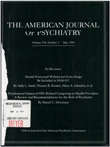Psychodynamics of suicide, with particular reference to the young
Abstract
OBJECTIVE AND METHOD: The article reviews the literature on the psychodynamics of suicide, focusing on factors that will help in evaluating and treating the young suicidal patient. Articles published in refereed journals and books and book chapters based on such articles are the source of most of the material. Articles that first brought a new finding to notice are given preference. Methodological limitations and contradictions with the data of other studies are pointed out. FINDINGS: The psychodynamic meaning of suicide for a patient derives from both affective and cognitive components. Rage, hopelessness, despair, and guilt are important affective states in which young patients commit suicide. The meanings of suicide can be usefully organized around the conscious (cognitive) and unconscious meanings given to death by the suicidal patient: death as reunion, death as rebirth, death as retaliatory abandonment, death as revenge, and death as self-punishment or atonement. CONCLUSIONS: Knowledge of the psychodynamics helps to distinguish which patients with any given diagnosis are at risk for suicide. Such knowledge is essential to the psychotherapeutic treatment of the young suicidal patient. Topics for future research include the role of anxiety in suicide; the capacity to bear hopelessness, rage, and other unpleasant affects without regression; the use of particular defense mechanisms in distinguishing the risk of either suicidal or violent behavior; and the relation of specific psychodynamic conflicts seen in suicidal patients to particular psychiatric diagnoses.
Access content
To read the fulltext, please use one of the options below to sign in or purchase access.- Personal login
- Institutional Login
- Sign in via OpenAthens
- Register for access
-
Please login/register if you wish to pair your device and check access availability.
Not a subscriber?
PsychiatryOnline subscription options offer access to the DSM-5 library, books, journals, CME, and patient resources. This all-in-one virtual library provides psychiatrists and mental health professionals with key resources for diagnosis, treatment, research, and professional development.
Need more help? PsychiatryOnline Customer Service may be reached by emailing [email protected] or by calling 800-368-5777 (in the U.S.) or 703-907-7322 (outside the U.S.).



